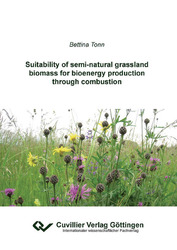| Fachbereiche | |
|---|---|
| Buchreihen (96) |
1378
|
| Nachhaltigkeit |
3
|
| Gesundheitswesen |
1
|
| Geisteswissenschaften |
2364
|
| Naturwissenschaften |
5406
|
| Mathematik | 229 |
| Informatik | 319 |
| Physik | 980 |
| Chemie | 1363 |
| Geowissenschaften | 131 |
| Humanmedizin | 243 |
| Zahn-, Mund- und Kieferheilkunde | 10 |
| Veterinärmedizin | 108 |
| Pharmazie | 147 |
| Biologie | 835 |
| Biochemie, Molekularbiologie, Gentechnologie | 121 |
| Biophysik | 25 |
| Ernährungs- und Haushaltswissenschaften | 45 |
| Land- und Agrarwissenschaften | 1004 |
| Forstwissenschaften | 201 |
| Gartenbauwissenschaft | 20 |
| Umweltforschung, Ökologie und Landespflege | 148 |
| Ingenieurwissenschaften |
1793
|
| Allgemein |
98
|
|
Leitlinien Unfallchirurgie
5. Auflage bestellen |
|
Erweiterte Suche
Suitability of semi-natural grassland biomass for bioenergy production through combustion
Bettina Tonn (Autor)Vorschau
Inhaltsverzeichnis, Datei (43 KB)
Leseprobe, Datei (92 KB)
Species-rich semi-natural grasslands with low-intensity management have a high nature conservation value. Due to the low digestibility of the mature herbage at the usually late cutting dates of these grasslands, their use in animal nutrition is limited. As a result, semi-natural grasslands are threatened by either intensification or abandonment of management in many parts of Europe. Production of bioenergy from semi-natural grassland biomass is an alternative utilization that can help to keep up the low-intensity agricultural management necessary for the conservation of these grasslands. Combustion is a particularly well-adapted conversion technology for the decentralized utilization of lignocellulosic biomass. However, as semi-natural grasslands have low biomass yields and the harvested biomass has a low energy density, it is not evident if its combustion will result in relevant net energy production and relevant greenhouse gas emission savings. Compared to other biomass fuels, moreover, few studies have focussed on the content of combustion-relevant elements in semi-natural grassland biomass. Available information points towards a sometimes problematic chemical fuel composition with high variability.
On the basis of a long-term field experiment with for management intensities, a life cycle assessment of semi-natural grassland biomass combustion was performed. Cumulative energy consumption and global warming potential of the experimental variants without N fertilization were 87-91% lower than those of a fossil fuel reference scenario. Acidification potential, however, was higher than in the reference scenario due to nitrogen oxide, sulphur dioxide and hydrogen chloride emissions.
The influence of maturity, botanical composition and site conditions on chemical composition of semi-natural grassland biomass was investigated in a field experiment at six grassland sites in southwest Germany. At these sites, the primary growth was harvested in monthly intervals from mid June to mid October. Chemical composition of the biomass was analyzed separately for the two species groups ‘grasses’ and ‘forbs’. Ash, N, K and Cl partly reached contents problematic for the combustion process. Ash and N are responsible for dust and nitrogen oxide emissions, for which legal emission limits exist. K and Cl play a key role in ash high-temperature behaviour. They are the cause of slagging, fouling and corrosion, which may severely impair the functioning of combustion systems. Variability of biomass chemical composition was largely influenced by differences between grasses and forbs and by nutrient availability at the experimental sites. Grasses had lower ash and N contents than forbs and were less strongly influenced by site effects. However, they had higher K/Ca ratios, leading to more problematic ash melting behaviour. Harvest date had a small effect on fuel quality. The K/Ca ratio, decreasing between June and October, was the only parameter showed a relevant change over time. These results point to a low potential for conflict between nature conservation targets and fuel production from semi-natural grassland biomass.
An experiment using biomass from two grassland sites of contrasting management intensity showed that leaching by rain during the field period can lead to strong reductions of K and Cl and to smaller reductions of ash contents. These leaching effects only occurred in dry but not in freshly cut biomass. There were also differences in leachability between biomass from the two grassland sites. For this reason, a laboratory method was calibrated against the leaching effect of simulated rain in a follow-up experiment. This method was used to assess the effects of different biomass characteristics and harvest dates on leachability. Differences in leachability between biomass from five grassland sites harvested on two different dates were found to be small and were not related to initial elemental contents. The results can therefore be considered to be representative for the primary growth of semi-natural grasslands. An analysis of long-term weather data showed that the option of using on-field leaching will not exist every year, so that technical leaching processes are of interest as well. A method adapted from combustion technology was used to investigate ash high-temperature behaviour of leached and unleached biomass. It could be established that leaching improved ash melting behaviour and reduced the release of volatile elements.
Knowledge about the factors influencing semi-natural grassland biomass chemical composition allows match biomass from specific grassland sites with the most suitable combustion technology and to identify grassland biomass of high fuel quality. For biomass of a less favourable chemical composition, on-field leaching is an option for fuel quality optimization. Semi-natural grassland biomass combustion therefore has the potential to combine biodiversity conservation with the production of bioenergy.
| ISBN-13 (Printausgabe) | 3869558768 |
| ISBN-13 (Printausgabe) | 9783869558769 |
| ISBN-13 (E-Book) | 9783736938762 |
| Buchendformat | A5 |
| Sprache | Englisch |
| Seitenanzahl | 182 |
| Umschlagkaschierung | glänzend |
| Auflage | 1 Aufl. |
| Band | 0 |
| Erscheinungsort | Göttingen |
| Promotionsort | Hohenheim |
| Erscheinungsdatum | 27.09.2011 |
| Allgemeine Einordnung | Dissertation |
| Fachbereiche |
Land- und Agrarwissenschaften
|








